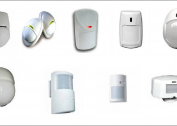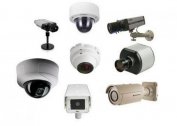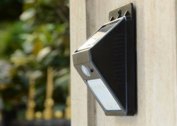To remotely control the operation of mechanisms, devices, an electronic long-range access device is used. The remote control is used to control production operations, communication systems, to coordinate the flight of unmanned vehicles, aircraft, missiles. A small flat case with keys is used to control consumer electronics from a distance.
Remote control device
 A household remote control is a box on the front of which are buttons. The remote control is powered by batteries and sends signals in the form of infrared rays (0.75 - 1.4 microns). The wave is not recognized by man, but perceived by the receiving mechanism. The design has a frameless or case microcircuit, which is located on a dielectric plate and filled with a polymer thermoplastic resin.
A household remote control is a box on the front of which are buttons. The remote control is powered by batteries and sends signals in the form of infrared rays (0.75 - 1.4 microns). The wave is not recognized by man, but perceived by the receiving mechanism. The design has a frameless or case microcircuit, which is located on a dielectric plate and filled with a polymer thermoplastic resin.
On the panel of the universal remote control there are basic parts:
- power button, device selection;
- volume control and channel switching, date and time settings;
- number keys for entering numbers;
- programming buttons;
- joysticks to navigate through the menu;
- keys, the purpose of which the user chooses;
- LCD or touch screen displaying current information.
For devices with many functions, you need a complex system with frequency control, it also protects the channel from interference and encodes the commands given. It uses digital conversion by remote control chip and decoding by the receiver.
The principle of operation of the remote control
 More often, devices use one frequency modulation (radiation of an LED element), on which the receiver and remote control are configured. Frequency values with constant amplitude are usually unchanged - these are 36, 38 or 40 kHz (Button, Canon, Pro Black). Rarely used indicators are 56 kHz (Sharp, Runva, Doorhan). Bang & Olufsen products operate at 455 kHz, which is a rare feature.
More often, devices use one frequency modulation (radiation of an LED element), on which the receiver and remote control are configured. Frequency values with constant amplitude are usually unchanged - these are 36, 38 or 40 kHz (Button, Canon, Pro Black). Rarely used indicators are 56 kHz (Sharp, Runva, Doorhan). Bang & Olufsen products operate at 455 kHz, which is a rare feature.
If the frequency of the receiver and transmitter does not match, the remote control will work, but its sensitivity will decrease. Several modulated pulse packets create a coded send, and the receiver contains a demodulator (transmitter), a filter circuit, and a frequency detector.
Previously, only the main commands of the controlled device were placed on the remote control; most of the controls were located on the body of household appliances. The situation has changed: you can only control ventilation, gates, lights, traffic lights using a remote device.
Types of wireless remotes
The devices are powered by 2 - 4 removable AA, AAA batteries, less often 9 Kron batteries are used. For the operation of the IR LED, 2.5 volts are needed, therefore several elements are required to ensure the remote control boundary. Specialists recommend alkaline or saline batteries.
By type of power there are remotes:
- autonomous;
- devices powered by an electric network 220 V or with a converter 360 V.
Portable devices are produced that are more often used in everyday life for wireless control of lamps, chandeliers, gate opening, tail lift operation, and other switches. The built-in IR remote control is mounted to control complex smart home systems or installed in industrial complexes to control, for example, a crane.
Functionality distinguish control devices:
- with a limited number of teams;
- with the choice of the number of orders (universal option, for example, the brand ABCD);
- with the possibility of learning a set of signals (trained models, for example, DC V).
- Remote Control ABCD
- DC V Remote
Communication with controlled equipment is established mechanically or by wire, using a radio channel, WI-FI, ultrasonic and infrared methods. The Trodfree driver adjusts the light in the home console, and the Wireless USB replaces standard wired transmissions.
Remote control circuit
To distinguish the commands of the transmitting unit, the encoding method is used. Before broadcasting the signal, the console issues one or several synchronous packets so that the touch receiver sets up the receiving circuit and synchronizes with the transmitter in phase and degree of sensitivity.
Two schemes have been developed for this purpose:
- The first system is used in the Philips remote control (in accordance with the RC5 and RC4 protocols). Sending signal 0 is supplemented by the number 1, and sending 1 requires the addition of 0. Signal 001 arrives in the form of 010110 and is read sequentially, and a simulated packet is fed into space.
- The authors of the second encoding scheme are Sony representatives. A unit is transmitted in a modulated burst, and zero means a pause. Zero transmits encoded information at the same unit time.
Studies have shown that signal duration varies by a deviation of time of + -10%. The transmitted packets are modulated by changing the frequency, which affects the range of the device.
How to make a do-it-yourself remote
A remote control is a device that can be assembled by converting a smartphone. You need to purchase infrared diodes or remove them from unnecessary remotes (2 pcs.) And a plug from old headphones. For assembly, you need emery, insulating tape and superglue, the work is carried out with nippers and a soldering iron.
For the manufacture of the stages are:
- On the one hand, the protruding laterally protruding elements of the IR diodes with sandpaper.
- Diodes with superglue are connected so that the turned side is inside.
- The legs of the diodes need to be bent and the extra protrusions dismantled with nippers.
- The anodes are soldered to each other with a soldering iron.
- A similar processing of the second diode ;.
- Both LEDs must be connected to the plug feet without observing the polarity.
- The place of soldering is coated with glue and protected with an insulating tape.
Connection mode is done via IR Port or WIFI, IR Blaster. The modification of the TV is selected and the action is confirmed. The redesigned smartphone is sent to the IR receiver of the home screen, the functions are under control.
Remote Control
 A universal remote controls several types of consumer electronics. Such a device differs from a local device, which is sold together with a washing machine, X-box or camera. A unitary enterprise is sold as a stand-alone product and is purchased separately.
A universal remote controls several types of consumer electronics. Such a device differs from a local device, which is sold together with a washing machine, X-box or camera. A unitary enterprise is sold as a stand-alone product and is purchased separately.
Different manufacturing technologies affect the final actions of the device and its cost. The controllers control one or more installations, the range of application is determined by the manufacturer. Trained models make it possible to specify a list of coordinated equipment by programming.
In everyday life, the IR remote control works with all modern models of household appliances, it is used in the complex home automation system for climate control, organization of burglary protection, opens and closes entrance openings, sets the operating mode of cooking and heating units.
Benefits of Remote Controls
The transition to remote control provides convenience for the user, since there is no need to move around the house to turn on the light, set the microclimate in the room. In an automated system, a person can use the remote control to provide high-quality work at home without getting up.
Remote response works successfully when objects are far from the operator, for example, when coordinating aircraft, aircraft, and cars. Beacons, repeaters, communication radio stations are controlled remotely and do not require the direct presence of a person.
Games such as the Xbox previously used a wired communication system, but replacing it with wireless remotes gives players more options.






